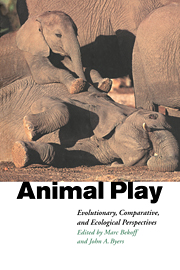Book contents
- Frontmatter
- Contents
- List of contributors
- Introduction
- 1 The evolutionary origins of play revisited: lessons from turtles
- 2 Play in common ravens (Corvus corax)
- 3 Object play by adult animals
- 4 Kangaroos at play: play behaviour in the Macropodoidea
- 5 Intentional communication and social play: how and why animals negotiate and agree to play
- 6 Structure-function interface in the analysis of play fighting
- 7 Sparring as play in young pronghorn males
- 8 Squirrel monkey play fighting: making the case for a cognitive training function for play
- 9 Self assessment in juvenile play
- 10 Biological effects of locomotor play: getting into shape, or something more specific?
- 11 Neurobiological sustrates of play behavior: glimpses into the structure and function of mammalian playfulness
- 12 Play as an organizing principle: clinical evidence and personal observations
- Index
8 - Squirrel monkey play fighting: making the case for a cognitive training function for play
Published online by Cambridge University Press: 20 November 2009
- Frontmatter
- Contents
- List of contributors
- Introduction
- 1 The evolutionary origins of play revisited: lessons from turtles
- 2 Play in common ravens (Corvus corax)
- 3 Object play by adult animals
- 4 Kangaroos at play: play behaviour in the Macropodoidea
- 5 Intentional communication and social play: how and why animals negotiate and agree to play
- 6 Structure-function interface in the analysis of play fighting
- 7 Sparring as play in young pronghorn males
- 8 Squirrel monkey play fighting: making the case for a cognitive training function for play
- 9 Self assessment in juvenile play
- 10 Biological effects of locomotor play: getting into shape, or something more specific?
- 11 Neurobiological sustrates of play behavior: glimpses into the structure and function of mammalian playfulness
- 12 Play as an organizing principle: clinical evidence and personal observations
- Index
Summary
Saimiri play in wild, semi-wild, and captive environments
Squirrel monkey (Saimiri sciureus) play behavior was first described almost 30 years ago in studies by Frank DuMond (1968) and John Baldwin (1969, 1971). These early reports were made under the benign observation conditions of the Monkey Jungle facility near Homestead, Florida. The provisioned four acre enclosed forest, referred to in the DuMond and Baldwin papers as a ‘seminatural’ environment, was home to over 100 squirrel monkeys of all ages, as well as other primate species. The extensive descriptions of play behaviors, partner preferences, and ontogeny observed at Monkey Jungle were confirmed a few years later by Baldwin's observations of wild squirrel monkeys in Panama and Costa Rica. At the National Institutes of Health ‘animal farm’ facility at Poolesville, Maryland, I observed monkeys in indoor and outdoor enclosures and found play indistinguishable from the earlier published descriptions. Only the frequency of play, responding to environmental stressors such as food shortages, was variable. It is reassuring that play has a basic conservatism and a reliability of behavior patterns over a wide range of settings, for much of our research has come from studies of captive animals.
At about five weeks of age, infants start to reach out to each other in rudimentary play while mounted on the backs of mothers who are resting side by side. During the second month, the infants slide off their mothers' backs, and wrestle vigorously beside the mothers as they rest, or try to rest. Nervous mothers retrieve very young infants from these earliest play fights. Later, it is rare for a mother to intervene, even if the play gets noisy.
- Type
- Chapter
- Information
- Animal PlayEvolutionary, Comparative and Ecological Perspectives, pp. 161 - 182Publisher: Cambridge University PressPrint publication year: 1998
- 38
- Cited by

